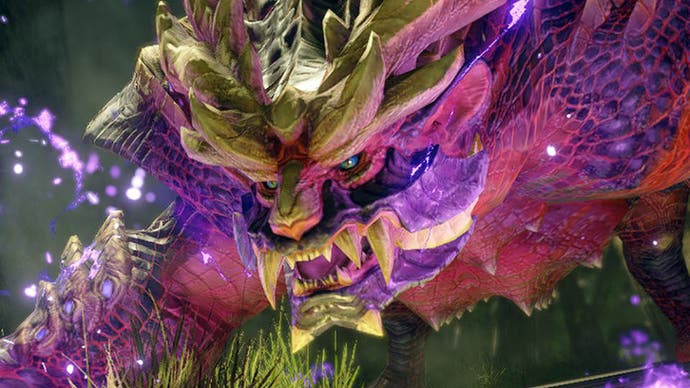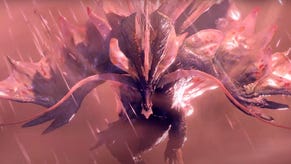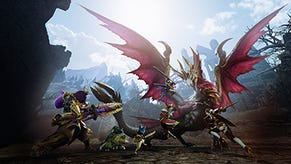Monster Hunter Rise's PS5 and Xbox Series ports deliver PC-levels of customisation
Beyond 4K resolution, 120Hz and more - the choice is yours.
Starting out as a Nintendo Switch exclusive, Monster Hunter Rise released in 2021 with a fresh take on the formula, built on Capcom's state-of-the-art RE Engine. It brought a new hub area and a bigger focus on vertical exploration - and all of it ran at a solid 30 frames per second at 756p. Yes, there were limits - like enemy animations cutting the frame-rate at a distance - and these were comprehensively addressed via a 2022 PC release, along with further enhancements. PlayStation 5 and Xbox Series versions are very similar, bringing across the visual refinements and excellent performance.
In fact, even the ability for PC users to tweak visual settings to their liking makes its way to all current-gen versions of the game with toggles for texture quality, texture filtering, shadows, ambient occlusion, foliage and post-processing. On top of that, there are multiple visual modes to choose from - including the ability to run the game at higher-than-4K resolution. On top of that, there's even support too. Put simply, all the knobs and levers are available to the player to tweak, should they so choose.
To make all of these options approachable for those that aren't interested, Capcom includes three global presets before entering the advanced menu: one to prioritise frame-rate, one labelled default, and another to prioritise graphics. From there, you can adjust those individual settings as you see fit, mindful that you may impact performance in doing so. This is quite important as if you're playing on a 60Hz display, all three of these modes target 60fps regardless. If your console's set to 120Hz, the frame-rate limit is uncapped and it is indeed possible to run the game effectively locked to 120fps via the frame-rate mode - or you can lean into VRR to steady lower performance levels and tap into higher quality visual effects. A little further down the page is a handy table, showing how the global presets adjust settings and define overall resolution targets.
Left as is, the prioritise frame-rate mode is barebones, but a good starting point if you want to target 120fps. The lack of ambient occlusion creates a flat, depthless world, there's no swaying foliage and textures are of a glaringly low resolution. Image quality also suffers as pixel counts suggest that the effective native resolution in frame-rate mode is 2016x1134. There's no dynamic resolution here: 1134p is what we get. If we reverse engineer that number back to 100 percent, the set resolution target would logically come out at 2880x1620. The frame-rate mode, then, gives us our absolute fail-safe mode for hitting 120fps - but it's quite a visual hit on all fronts.
Next up, there's default mode. This is much more like it, though ideally you're aiming for a 60fps experience for this one. On default, the target resolution is pushed to a true 4K - and at 100 percent image scale, you do get 3840x2160, creating a much crisper image. Default also enables options for high-res textures, ambient occlusion and foliage sway - adding far more depth and movement to the scene. The shadow quality option also gets pushed to medium, while texture filtering bumps up to high. We're getting almost everything maxed out here, besides the maxed out shadow setting. For hitting a locked 60fps, this is the one.
Finally, there's the prioritise graphics mode. This final mode is a bit of an extra for visual purists and doesn't always lock at 60fps. It boosts the resolution to 125 percent scale though, which is a real surprise. The output resolution is still 4K here, but the game is supersampled down from a 4800x2700 image. Or to phrase it another way, it's rendering at 4.8K - adding a form of brute force anti-aliasing by scaling a higher-res image down to 4K.
| Frame-Rate Mode | Default Mode | Graphics Mode | |
|---|---|---|---|
| Native Resolution | 2016x1134 | 3840x2160 | 4800x2700 |
| Series S Native Res | 1344x756 | 2560x1440 | 2560x1440? |
| Image Quality | 70% | 100% | 125% |
| High Res Textures | Off | On | On |
| Texture Filtering | Low | High | High |
| Ambient Occlusion | Off | On | ON |
| Shadow Quality | Low | Medium | High |
| Foliage Sway | Off | On | On |
All of this applies on the Xbox Series S version as well. The settings are exactly the same as the PS5 and Series X in using each mode, from textures to shadows to foliage. The only difference is the drop in resolution. For the frame-rate mode, the target is 1080p, but with image quality set at 70 percent, the true native resolution is 1344x756.
Next along is the default mode, getting us to 100 percent of 1440p. Curiously, I found the graphics mode also seems to push a practically native 1440p image. While edge treatment is better than the default mode's 1440p, the pixel structure isn't visibly different. A mystery then - and potentially graphics mode is running at a higher value. Still, all round, it's a respectable way to scale for Series S's 4TF of GPU power.
Pitting PS5, Series X and S against one another on their maxed out graphics modes, it's the exact same image, outside of resolution. Cross-platform comparisons are a little bit of a moot point, really. We know exactly what settings we're using on each after all. Perhaps more revealing is how Nintendo Switch slots in. Monster Hunter Rise is a Switch game at its core and to be blunt, the new enhancements are more 'nice to have' features as opposed to a total visual revamp. Texture mapping on skin, materials across the shrines, and shadow resolution are boosted on PS5's max graphics preset. We also get dynamic shadows from trees above - not enabled on the Switch release. Plus, the resolution upgrade from 756p on Switch to 4.8K on PS5 is also clearly huge - but bearing in mind the Nintendo system's capabilities, I still think the Switch version holds up beautifully.
Performance-wise, all three modes target 60fps on a 60Hz display or 120fps if you've a 120Hz display connected - but that doesn't always mean they'll actually hit those targets. The trade-off is up to you. If you want 125 percent image quality, or high shadows for example, you're not guaranteed to lock at 60fps on PS5 or Series X. How smoothly the game runs, or which visual features you want, is put entirely in your hands - much like a PC game.
As far as PS5, Xbox Series X and S go, the default mode is the best starting point for 60fps. Exploring the hub area, the Shrine Ruins, the Frost Islands, it barely skips a beat. Admittedly there are ways to stretch the RE Engine, by playing further into the game, or adding more ally hunters in co-op - but the outlook is promising. PS5 nails it across the board for solo play at least and likewise for Series X, it's a fluid experience all the way through on the default option.
Again, it goes back to the Switch origin of the game design, a world framework built for a far less powerful system, meaning that bumping the resolution to 4K doesn't have an impact at all on either premium machine. And I'm glad to say, Series S follows suit too with a fluid 60fps on default mode, rendering at 1440p. Even adding dynamic shadows doesn't affect playability at all here.

Looking for 120fps? Frame-rate mode does the trick and if you have a VRR display, you can toggle on other features in exchange for a hit to performance that may pass by unnoticed. Similarly, if you choose the graphics option on a 60Hz screen, performance will drop from the target 60fps - but again, the impact can be mitigated with VRR. Comparisons-wise, it's curious to see that in matched like-for-like scenarios, PlayStation 5 has a small but measurable frame-rate advantage over Xbox Series X at 120Hz but ultimately, 4K60 on the default mode is winner for both premium machines.
Overall, the biggest upgrade for Monster Hunter Rise on the latest consoles is clear. Running at 60fps or 120fps is a huge upgrade over Switch's 30fps. The move to 60fps and beyond has a serious, tangible effect on the action and the hardware is more than up to the task. Equally, there are the loading speeds, which are so rapid on the newer consoles that the fade-to-black barely takes a second between areas.
The option for a 4.8K resolution is an eyebrow-raising bullet point, but not a revolution in practise. However, the PC-like options menu gives players a high level of flexibility to customise as they'd like in addition to the global presets typically seen in a modern console game. In conclusion, the port ultimately lands where expected and it's great to see Rise on all platforms now - with the extra configurability adding a welcome pinch of extra spice.


















